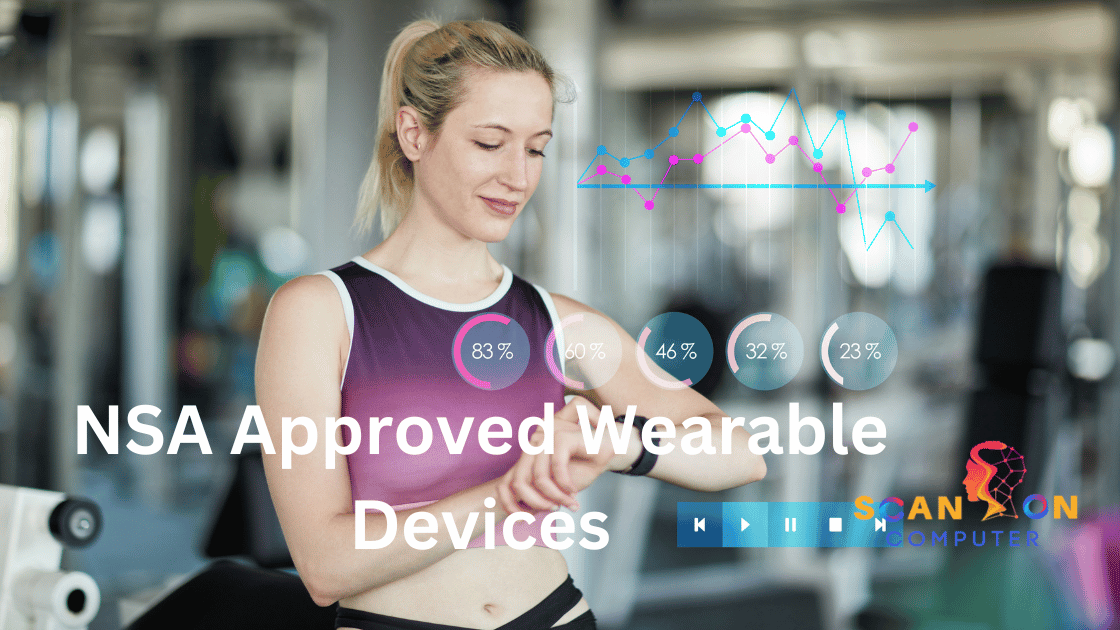Wearable devices approved by the National Security Agency (NSA) measure various acoustic and aerodynamic metrics, including fundamental frequency, cepstral peak prominence, sound pressure level and subglottal pressure. This data collection occurs continuously without the user experiencing discomfort or interference.
5 NSA Approved Wearable Devices
These data can have significant clinical applications for DoD personnel. Table 1 lists common commercial wearables with built-in sensors and their cardiovascular clinical applications.
1. Fitness Tracker
Fitness trackers have been around ever since Thomas Jefferson began using his watch to track his calories, with modern versions such as Apple Watch or Garmin watches and Oura rings becoming ubiquitous devices that track body activity and calories consumed.
Fitness trackers have become an invaluable tool to assist in improving overall health and wellbeing. They can record your daily steps, calories burned and distance covered; sync with smartphones for sharing progress reports with friends and communities – offering accountability that keeps people motivated with long-term workout plans.
Some trackers can detect changes in posture, heart rate, body temperature and more, while some send your activity data directly to third-party platforms that could use it for marketing or research. Because of this potential use case it is important to read all fine print before purchasing such devices.
Tracking activities may be encouraging, but tracking can become addictive if it becomes an obsession. If tracking is becoming overwhelming for you and you feel bound by certain step goals that have to be reached, perhaps it’s time for change.
Fitness trackers have raised privacy issues due to their geolocation capabilities. A 2018 memo issued by the Department of Defense warned service members in sensitive areas and at high-profile bases against using fitness trackers as this may expose their locations to adversaries. If working at a DoD facility without needing a security clearance clearance is possible for you then using one might be an alternative option.
2. Sleep Monitor
Consumer wearables that claim to track sleep have seen exponential growth due to advances in sensor technology (such as miniaturization, low cost and power consumption), software integration and connectivity as well as user interfaces designed for ease-of-use. Wearable devices designed as sleep trackers allow users to record biosignals such as heart rate variability, skin conductance temperature and motion which provide insight into behaviors including sleeping.
These devices offer numerous advantages over traditional sleep monitoring techniques, from being worn comfortably for extended periods without needing technical staff or specialist data processing to their convenience in natural settings. Unfortunately, however, numerous limitations and challenges exist with using such devices in research and clinical environments; from having limited published validation studies to their hidden complexity.
An important complication in tracking sleep involves the lack of an objective definition for different stages, with their determination dependent on multiple inputs. Furthermore, users often evaluate sleep trackers based solely on accuracy; this may not provide an adequate gauge of data produced. A better measure would be ratio of sensitivity to specificity.
Sleep-trackers are currently widely available on the market, from simple devices like Fitbit Inspire 3 and Rhythm to more sophisticated Smartwatchs such as Fitbit Sense 2. Oura Ring is another device which tracks various parameters related to your sleeping habits such as resting heart rate, movement and brain activity (the latter via electroencephalography), as well as when you wake up so it can play audio to lull you back to sleep.
3. Heart Rate Monitor
Fitness trackers are an invaluable way for individuals with cardiovascular conditions such as high blood pressure or heart disease, or who wish to prevent them, to monitor their health. Fitness trackers can alert users to potential issues by detecting irregular heart rhythms or high activity levels – potentially warning signs for heart attack or stroke.
Numerous wearable devices, including smartwatches, wristbands and rings, contain built-in heart rate monitors. Using photoplethysmography technology they measure how your arteries expand when your heart pumps blood out; others estimate oxygen saturation levels; some even offer features to detect atrial fibrillation episodes (AFib).
Wearable devices designed to aid people in managing their fitness and well-being rather than medical devices often have limited accuracy; sensors used to determine resting heart rate may give inaccurate readings; similarly, energy expenditure estimation (EE) accuracy depends on various factors including type of activity performed, body posture taken up during exercise sessions, sex status/skin tone as well as clothing worn.
Wearable devices are now being utilized to detect early warning signs of COVID-19 infection before symptoms appear, including elevated resting heart rate and changes in daily activity patterns. Utilizing algorithms to analyze this data collected by these devices could make these tools even more effective at identifying people who may have become infected and helping them isolate themselves in order to limit further spread of the virus.
Fitness trackers and wearable devices have become an increasingly popular informational tool, but their limitations must still be taken into consideration by users and healthcare providers alike. Manufacturers should provide more clarity regarding clinically proven capabilities while healthcare providers learn to interpret metrics reported by these devices.
4. Blood Pressure Monitor
A blood pressure monitor measures the force with which your heart beats against the arteries, recorded as two numbers: systolic pressure and diastolic pressure. An ideal healthy range for both is 120/90; anything beyond this threshold could result in stroke, heart disease or kidney disease – not to mention damage to other systems as a whole.
Automatic digital monitors are the most frequently used type of blood pressure monitors. These devices feature a cuff that fits around your upper arm, inflates either manually or automatically and displays measurements easily on a screen. Digital monitors may also allow users to store data or link with apps; for accurate readings it’s best to select one that fits perfectly on your upper arm while not applying too much pressure (like wrist or finger monitors).
Home monitoring of hypertension symptoms can provide valuable insight into whether treatment is working. The American Medical Association suggests using a digital, cuff-style, upper arm monitor for reliable readings that reflect normal behavior; you should wear this for at least 24 hours to get reliable readings that accurately represent you and your daily activities.
The 2022 National Defense Authorization Act mandates that the DoD devise a holistic health strategy to enhance military readiness, with wearable devices collecting voice-related metric data to detect and prevent voice disorders like vocal cord atrophy and chronic airway inflammation. With this information at their disposal, new products, services, and optimal work environments for service members could be developed and engineered accordingly.
5. Blood Sugar Monitor
Wearable devices have become an invaluable aid to monitoring blood sugar levels for people living with diabetes. Unfortunately, however, they still fall far short of replacing more invasive finger stick tests as a method for checking glucose (blood sugar) levels.
Note that differentiating health/wellness data from medical information may be difficult for everyday users of these devices due to their ability to monitor multiple metrics simultaneously. For instance, heart rate sensors found in some fitness watches may detect atrial fibrillation (AFib), an indicator of cardiovascular disease. Therefore, consumers should do their own research prior to purchasing devices that track both types of information.
For those living with diabetes, the National Security Agency has approved continuous glucose monitoring (CGM) systems which can accurately track their blood glucose levels without having to prick their skin in order to do so. Some smartwatches such as Apple Watch Series 7 come equipped with CGM systems as part of its offerings.
Medicare includes CGM systems as durable medical equipment (DME), which refers to health-related equipment prescribed by your doctor that allows you to manage a condition at home. When selecting a DME supplier, make sure they’re Medicare approved and enrolling with Medicare; additionally, the provider must accept assignment so you aren’t charged more than your coinsurance or Part B deductible amount.
NSA has also approved of wearable devices that are capable of tracking people’s blood pressure and heart rate by measuring oxygen intake in their bodies as well as tracking their location via GPS systems, though their accuracy remains in dispute, leading to potentially misleading health decisions based on seemingly accurate information.













